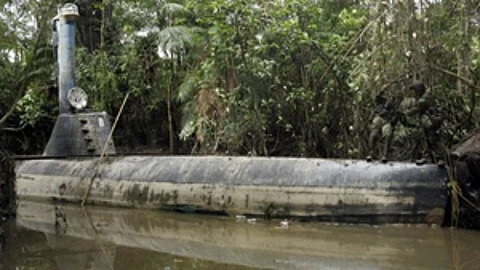

Over the past three months, interdictions of drug-smuggling sub-surface craft have made the headlines. The US Coast Guard intercepted two cocaine-laden semi-submersible craft in the Caribbean, while Colombian police seized a fully submersible submarine near the Pacific port city of Buenaventura. The Colombians say the sub was being prepared to convey a shipment of cocaine to Central America.
The clandestine movement of illicit narcotics across borders has long spawned criminal ingenuity. Examples of this include hidden compartments in vehicles, aircraft and vessels, and the extensive use of human "mules" to carry drugs hidden on, or within, their bodies.
A major element of the transnational illegal narcotics highway is the Colombia-Mexico route, which feeds into the hugely lucrative North American market. For many years, the drug kings favoured multi-engined speedboats and light aircraft to transport their illicit cargoes along this route. Law enforcement, however, evolves to meet challenges, and the past twenty years have seen the deployment in anti-narcotics roles of US Coast Guard HC130H and the US Navy P3 Orion maritime patrol aircraft, as well as the US Customs Service's P3 long-range radar surveillance planes. Moreover, many US Coast Guard and US Navy surface vessels are now equipped with very advanced surveillance and tracking equipment, and the capabilities of other regional navies have also improved in this regard.
This proliferation of advanced smuggling countermeasures was the catalyst for the addition of stealth technology to the narco-barons inventory, in the form of semi-submersibles. These craft are built with buoyancy characteristics that enable them to conduct drug delivery voyages with about 80 percent of their hulls under water, ensuring that they give a weak radar return.
The vessels are constructed in remote areas of Colombia, usually from fibreglass and kevlar, occasionally of steel. With crews of up to four men, they are about 20 metres long and are equipped with radar and radio. A dedicated helmsman's cab is fitted. Propulsion is by single or twin diesel engines, enabling a speed of about 11 knots.
Operational ranges of about 2,000 nautical miles have been reported, with typical carrying capacity being 7-10 tonnes of cocaine. Occasionally, profits are boosted by return cargoes of illicit items such as illegal arms. Crew members reportedly receive at least US$3,000 per trip – one is invariably an armed enforcer charged with ensuring that the others stick to the task in hand.
Drug syndicates often hire fishing boats to monitor the passage of their submersibles, and to replenish them with food, fuel and water while underway. The submarines' drug cargoes are transhipped to such vessels offshore for the final part of the voyage, and the sub is then usually scuttled.
Some intelligence reports indicate that craft of this type are now occasionally conducting unmanned passages, under the remote control of surface ships operated by the drug syndicates.
The use of such vessels poses serious problem for law enforcement, as they are not readily detectable by radar, sonar or ordinary eyesight, particularly in rough sea conditions. Nevertheless, since 1993, advances in intelligence and technology have resulted in some 40 examples being detected by the US Coast Guard or regional navies, though the craft are often scuttled before they can be seized. US legislation, incidentally, now allows the prosecution of captured crew members for operating an unregistered submersible vessel, and a number of such cases are awaiting trial.
The drug runners are again upping their game by commissioning true submarines. Two such vessels have so far been seized in South American inshore waters, both apparently before construction had been completed, each up to 31 metres in length and capable of carrying up to 200 tonnes of cocaine. Powered by twin diesel electric motors, these fully submersible narco-subs are equipped with air-conditioning and periscopes. Coupled ballast tanks are fitted, enabling a diving depth of 20 metres or more. The sophisticated nature of the two seized subs leaves no doubt that experienced naval architects are involved in the design and construction of such craft. It is not clear whether such submarines have yet successfully accomplished any narcotics delivery voyages.
The use of drug-running submersibles off the American continent has been well publicised, but such activity may not be confined to these waters alone. Investigators have reportedly uncovered plans to use them to deliver illegal drugs to Europe. In 2009 the Sri Lanka Army discovered a submarine deep in the jungle, constructed by the maritime wing of the Tamil Tiger rebel movement, an organisation with strong connections to the illegal drugs trade. Also, since 2000, at least five locally-built submarines, reportedly built with assistance from Sri Lankan individuals, have been seized on shore at Phuket, Thailand, and there have been reports of sightings of such vessels off the Thai coast. It may be only a matter of time before a loaded narco-sub is apprehended in Asian waters.
Trevor Hollingsbee
